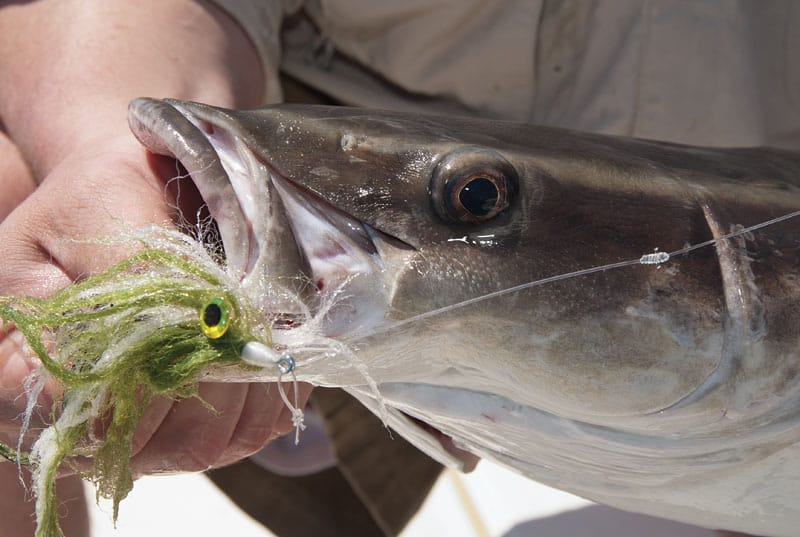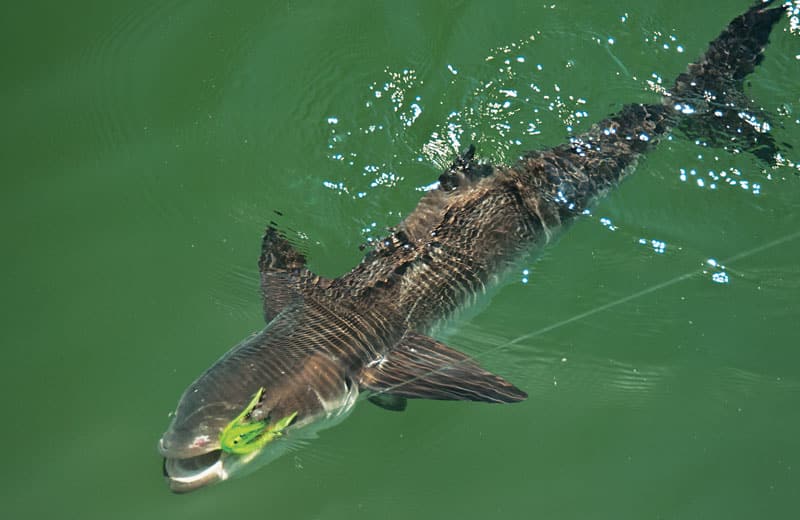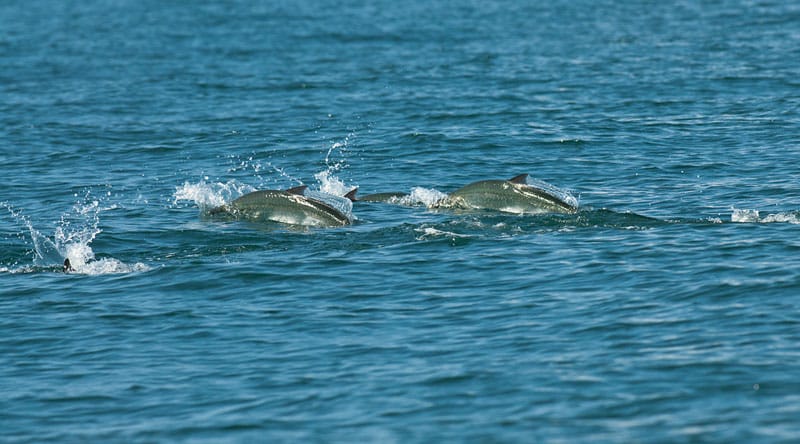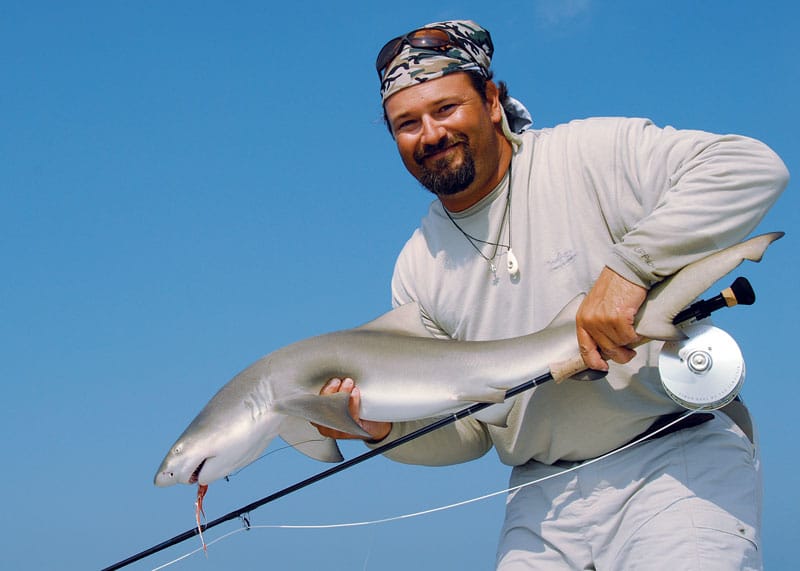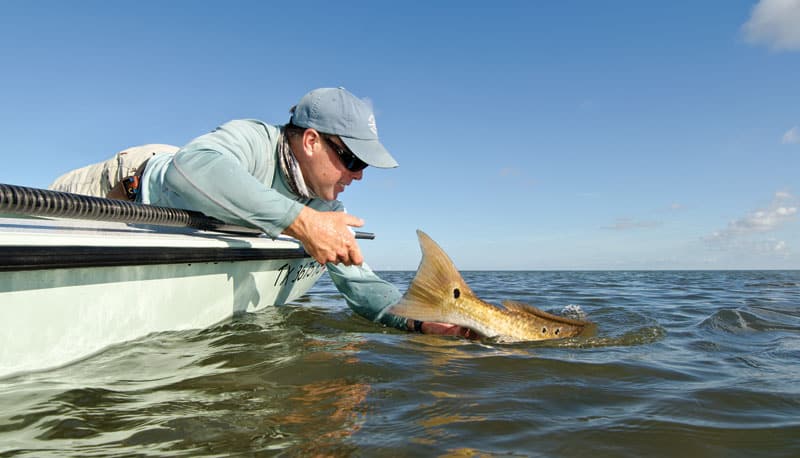
July 4 of 2011 was a great day to be an angler in Texas. We had great weather and a pretty decent tide. My friend Brandon Smith and I had a sneaking suspicion that we could find active schools of jacks feeding in deeper water around the passes.
So we awoke ridiculously early, launched the skiff and pointed it toward our nearshore target. Shortly before arriving at our destination, we began to make out several large concentrations of working birds and altered our course to intercept them.
Immediately upon reaching the birds, Smith made a cast into the frenzy — in no time flat, he was hooked up to his first-ever jack crevalle on fly. After I snapped a quick photo, it was my turn. Just like Smith, I found myself tethered to a fat crevalle in short order. During the battle, we both noticed that several bull redfish had made an appearance among the ravaging jacks. Smith knew exactly what to do and broke out another rod. After a few failed attempts, he finally hooked up to his largest redfish to date. “Wow! Didn’t expect that to happen today!” was all I could say.

When we were done with the all of the photos, the action outside of the channel had died off, so it was time to crank the motor and get back on our original course. By the time we reached the pass, several other boats had moved into the area and were dropping cut bait below large schools jacks and doing a pretty good number on the oversize reds. The bait-chucking boats made it a bit difficult to get into position to cast a fly into the surface-blitzing fish, so we decided to go way up-current and just drift. We hoped that some fish would surface in our path and provide us with a few more opportunities.
After several unsuccessful drifts, we were ready to pull the plug and head for the house. However, just before we threw in the towel, a few fish surfaced near the boat and I made a cast. The instant the fly hit the salt, the water began to boil 360 degrees around the boat as a large school of redfish emerged. I of course hooked up immediately, but even more exciting was that the fish in the school were so abundant and voracious they were actually slamming into the boat from every direction. Talk about being in the right place at the right time. It was without a doubt one of the most spectacular experiences of my life. Sure, I have seen plenty of large schools of blitzing bull reds before, but to be smack-dab in the middle of it — oh my goodness!
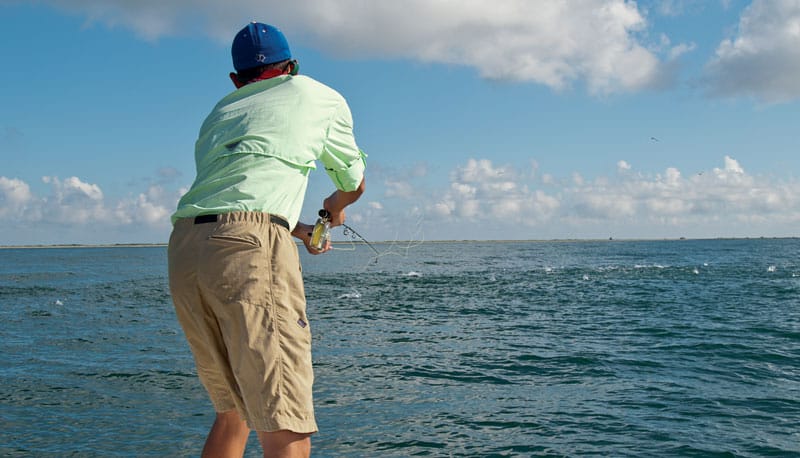
Gulf Activity
From the Florida Everglades all the way to the Rio Grande, more and more fly-fishermen are leaving the flats and making their way to the beachfronts, passes and jetties of the Gulf of Mexico during the summer months to find action. They go there in search of something that will run a little bit faster and fight a little bit harder. The options are abundant no matter where in this region you call home or plan an angling vacation.
If you are in south Florida, you might consider trying your hand at finding permit and cobia off of a nearshore wreck. Or how about moving north to the Homosassa area and attempting to fool grouper in shallow water? Then again, around mid-September, there is some great tarpon fishing to be had along the west coast of Florida and some unreal bull redfish action off of the Mississippi. Moving even farther west to the Texas beachfront, you can try getting your knuckles busted by the scorching run of a kingfish.
Truth be told, every state along the Gulf Coast allows for opportunities at tarpon, jack crevalle, cobia, kingfish, bull reds and myriad other species at some point between spring and autumn, though permit are exclusive to the nearshore wrecks of south Florida.
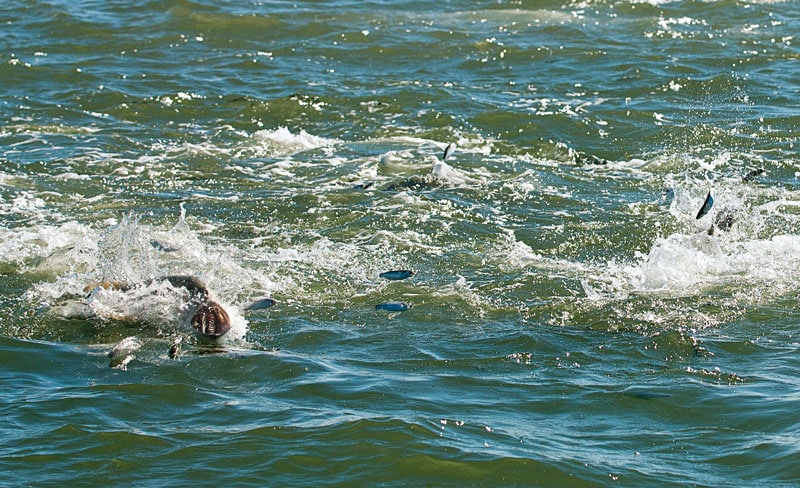
Easy Access
Because they can be found in the surf and at nearly every pass and jetty system along the entire Gulf Coast, species such as redfish, spotted seatrout, Spanish mackerel and jack crevalle are the most popular and easiest to access nearshore fish. While wading into the surf and casting blind between the guts is the norm, it is not uncommon (when conditions are right) for anglers to walk remote beachfront areas sight-casting to small groups or individual fish cruising just inside the first sandbar. Having a boat obviously increases an angler’s ability to cover more water and allows access to schools of surface-blitzing fish past the surf line and in the middle of deeper passes.
When you’re fishing beachfronts for small schools or individual fish, fly selection and matching the hatch become critical. Observe what the fish seem to be eating, and select offerings carefully. As for large schools of redfish and jacks exploding on the surface, large poppers and patterns imitating large baitfish seem to work most of the time.
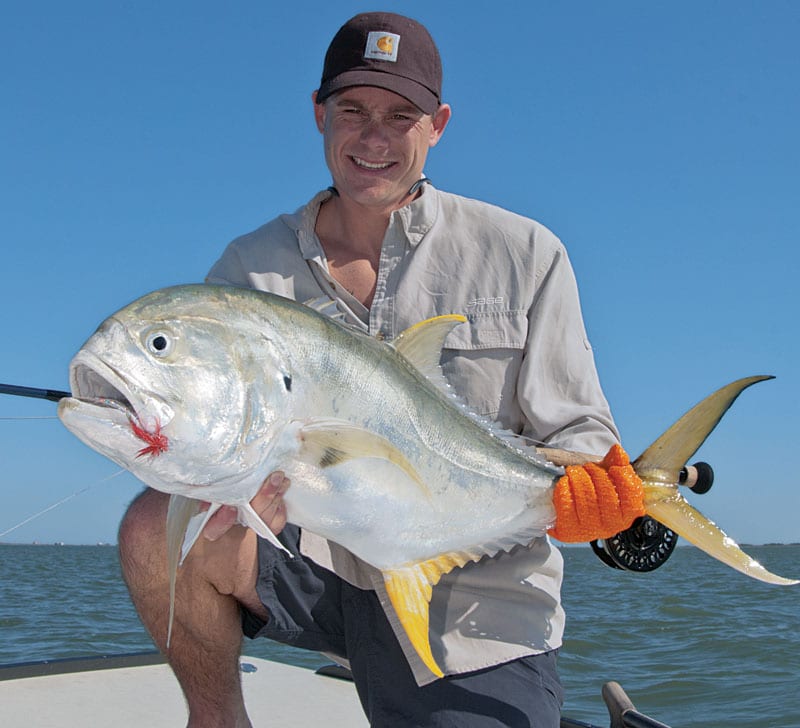
Just Offshore
When light winds coming from favorable directions allow the nearshore waters of the Gulf of Mexico to calm and clear, many offshore species frequently hang out within a mile or two of the beach. Cobia, kingfish and little tunny often can be found within sight of the sand or at the ends of jetties.
Probably the most popular of these species is cobia. If you fish in Florida, start looking for them riding the backs of rays nearshore during March as they follow the warming waters to the beach. Some of the best action occurs near the Panhandle in mid- to late April. In the northern, more western Gulf, it is not uncommon to find cobia cruising on the surface near the jetties or around anchored shrimp boats during late summer. Another good spot to find cobia is beneath the buoys that mark the channel or production (oil and gas) standpipes within a few miles of the beach. Once spotted, cobia are generally easy to approach, and it usually takes only one well-placed cast and a couple of quick strips to entice one. Should the fly be refused, get it out of the water immediately and slap it down just in front of the fish’s nose. Never let a cobia look at an offering too long. Large crab patterns and dark eel-like flies seem the most effective along the Gulf Coast.
Kingfish are yet another nearshore fly-rod favorite. Every summer, kings can be found around shrimp-boat fleets as they move closer to shore. The small schools of kings roam the beachfront, moving from boat to boat, gorging on the culled bycatch from the anchored craft. As the schools maraud, some inevitably stop around the jetties to feast on the mullet, menhaden, ribbonfish and glass minnows that congregate around the rocks.
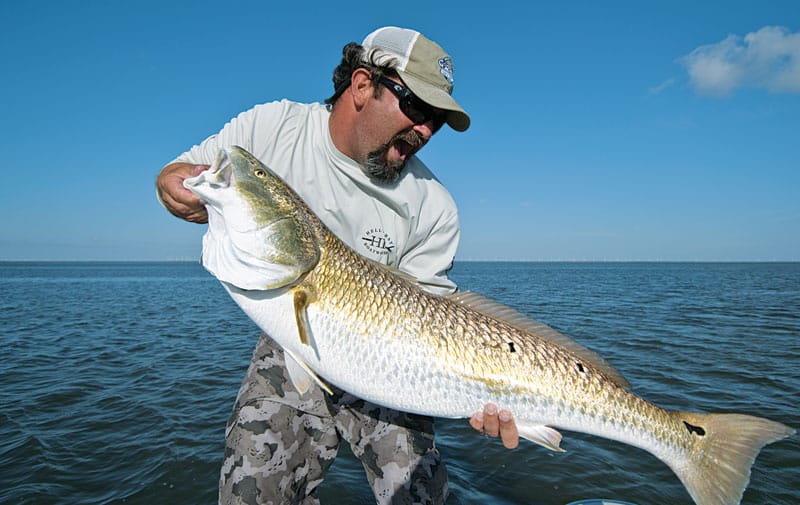
While searching a mile or two off of the beach for kings, key in on the shrimp boats that are culling their catch (which is also a great way to locate large jacks). The fresh bycatch provides a very large chum slick that attracts predatory species and allows you to focus your search area. While at the ready on the bow, have a fishing buddy slowly idol the boat into the slick from down-current, then make your casts into the fresh chum. Retrieve the fly quickly, but if a strike does not occur by the time the boat reaches the trawler, try dead-drifting beneath the trawler a fly pattern similar in shape and size to the bycatch being tossed overboard. As for fishing the jetties for kings, concentrate your efforts outside of the channel near the end of the rocks, keeping an eye out for heavy concentrations of bait near any drop-offs. Of course, every jetty is different, and it is important to learn the subtleties of each one.
Little tunny (aka bonita), they most likely going to appear in large surface-churning schools near the ends of the jetties or just outside of them. Poor man’s tuna, as they are often referred to, are easily accessed by flats skiffs along most of the Gulf, and they readily take small, rapidly retrieved baitfish patterns. Once hooked, they are capable of screeching runs that consume a great deal of backing, so be forewarned. While many are landed with 7- to 8-weight rigs, 9- to 10-weights are more appropriate.
Tarpon
When people think about tarpon fishing, the first place that comes to mind is the Florida Keys, the epicenter of all things tarpon; however, most of those fish leave and eventually end up somewhere else. It has been suggested that there are two groups of tarpon in the Caribbean that migrate northward annually. One group is said to come up the west coast of Florida, and the other up the coast of Mexico and Texas. Both merge sometime during late summer at the mouth of the Mississippi River, where they mingle before returning. It was long believed that they always followed the same route back, but recent tagging studies suggest that some may just go straight into the Gulf. The point is that Gulf anglers often get opportunities at tarpon along the beachfront, especially near passes and jetties, as the fish come through on their way to and from the Mississippi annually.
Truth be told, it can be difficult to find unmolested fish along many Gulf beaches. The run-and-gun tactics that many anglers use often keep the fish down or way too spooked to eat a fly. However, if you can find “happy” fish, all you need is patience and a good, long cast. Use a trolling motor to get in position way ahead of the schools, or anchor along known paths and then lead the fast-moving fish with clear intermediate lines and sizable baitfish imitations. With rolling fish at the jetties, small baitfish and shrimp flies on fast-sinking lines seem to provide the best results.
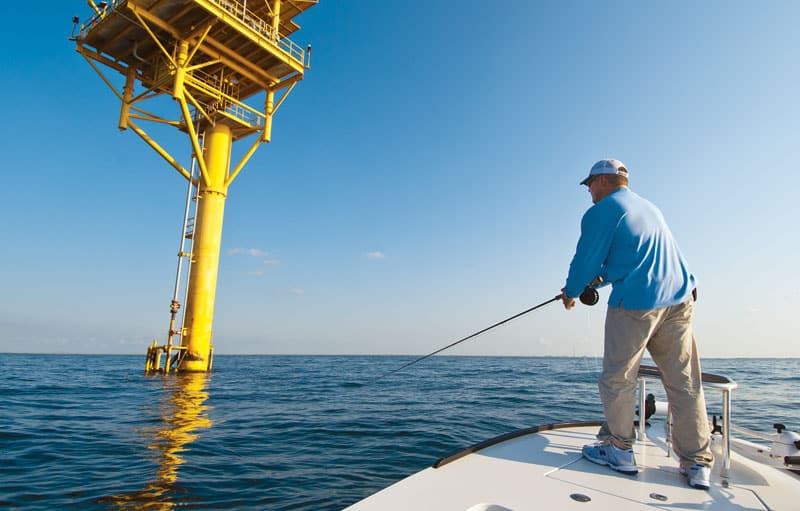
TRIP PLANNER
Chandeleur Islands
The Chandeleurs sit just west of the Mississippi Delta and offer a unique experience for fly-fishermen. The totally uninhabited island chain is remote and best fished from a mothership-type operation. Offering opportunities at large schools of bull redfish, jack crevalle and tarpon, numerous species of sharks, and more trout than you could ever wave a fly rod at, the Chandeleurs are definitely a just-visit-before-you-die kind of place.
Padre Island National Seashore Essentially stretching from Corpus Christi to Port Mansfield, Texas, PINS is a beautiful destination for do-it-yourself anglers. With a beach permit and a four-wheel-drive vehicle, anglers can experience miles of great scenery and wildlife viewing, as well as cast from the beach to redfish, jack crevalle, trout and Spanish mackerel. Throw in the occasional opportunity at a tarpon, and this place becomes tough to beat.
